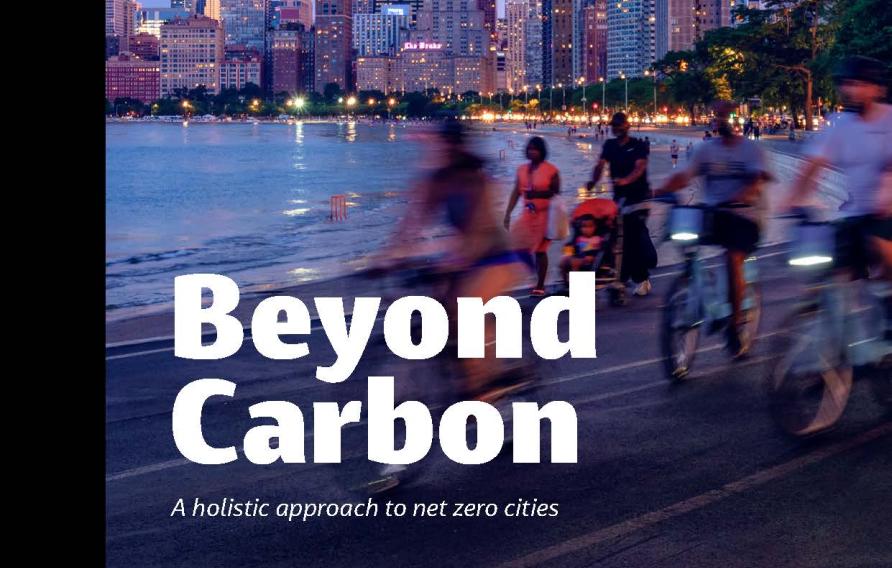
The need to reduce carbon emissions while scaling up our cities to meet the demands of urban growth has implications for how we design, construct, operate and maintain buildings. Find out why “going green” needs to be at the top of your priority list and the solutions that will get you there.
In our latest insight paper Investing in Sustainable Buildings we:
- Outline the need for further investment in sustainable buildings.
- Identify the potential solutions to improve sustainable building design, construction, operation and maintenance.
- Present a preliminary analysis of current and emerging solutions that can help decarbonize the built environment.
Net zero and the built environment
Decarbonizing buildings has a vital part to play in reaching global net zero greenhouse gas (GHG) emissions.
The world is currently undergoing the largest wave of urban growth in human history. By 2060, two-thirds of the expected global population of 10 billion people will live in cities of some form.1 To accommodate this growth, cities need to roughly double the current floor area available. To put it into perspective this means adding a floor area equivalent to the area of Manhattan in New York City every month for the next 40 years.

Figure 1: Projections show cities must add the equivalent area of Manhattan (NY) (59km²) to the global building stock every month, for the next 40 years.
At the same time, when including building construction, the buildings sector today is responsible for approximately 35% of global energy use and 38% of global GHG emissions.2 With more and more countries, cities and businesses committing to net zero emissions by 2050 or sooner, decarbonizing the buildings sector will play a vital role in achieving that target.
These figures highlight the huge potential for the buildings sector to contribute to reducing global GHG emissions by designing and delivering more sustainable buildings.
Why invest in sustainable buildings?
While people and the planet are the ultimate winners of a more sustainable, net zero future, positive environmental outcomes are not the only advantage of sustainable buildings. Put simply, the greener the building, the more it’s worth.
There are a number of bottom-line benefits to going green.
Tenants and investors are increasingly gravitating to energy efficient and sustainable buildings.3 Such buildings have also been shown to attract higher values, known as a “green premium.” For example, in Sydney and Melbourne, buildings that have been awarded a 4.5-star National Australian Built Environment Rating System (NABERS) sustainability rating are worth on average 8% more than comparable unrated buildings on a per square meter basis and for buildings awarded between a five- and six-star rating this can increase to 18%.4 In London, highly rated buildings are worth 10% more than comparable unrated workplaces5 and in the U.S.A. evidence shows that green certifications like Leadership in Energy and Environmental Design (LEED) result in a sales premium of up to 7.6%.6
Key principles underpinning sustainable design
Not all sustainable buildings are the same. The climatic conditions and cultural needs, as well as wide-ranging environmental, economic and social priorities means the challenges and demands of sustainable buildings will vary between countries and even regions.
However, there are many shared guiding principles of sustainable building design and delivery that are a critical consideration for any built environment asset, as shown in Figure 2.

Figure 2: Five guiding principles of sustainable building design
Retrofitting versus new construction
There are two ways to deliver sustainable buildings — constructing new, more efficient buildings or improving existing buildings through a retrofitting program.
Retrofitting buildings can improve building performance, significantly reduce energy and water usage and improve amenities for occupants. Retrofitting also offers the ability to retain the significant resources already embedded within them which would otherwise be wasted if the building was demolished to make way for new construction. New construction on the other hand guarantees a fit-for-purpose asset, greater design flexibility and may be more adaptable to future or changing urban needs.
When we consider the contribution of the building sector to current GHG emissions and the scale of construction that must take place in cities to accommodate future growth in urban populations, it is clear both approaches are part of the solution.
As Jeff Merritt, Head of Internet of Things (IoT) and Urban Transformation at the World Economic Forum says:
“In order to meet the goals of the Paris Agreement to limit global warming, we need to see in the next ten or so years the majority of our buildings become net zero carbon. Any guess on how many cities currently meet that goal? Less than one per cent. There is a staggering challenge here.”7
Just how staggering is well illustrated by the statistics below.
-
75 %
Buildings in the European Union classed as energy inefficient (8)
-
< 1 %
Global building stock achieving net zero emissions (9)
-
230 b
Additional square meters of floor area needed to accommodate predicted urban growth by 2060 (10)
Emerging solutions
Regardless of whether you’re retrofitting an existing building or designing a new one, the first step on the sustainability journey is to capture an inventory of potential sustainable building solutions and begin the process of evaluation and selection. There is a growing list of decarbonization solutions that can potentially be incorporated into building designs that tackle both operational emissions and embodied emissions as shown in Figure 3 below.

Figure 3: Embodied and operational carbon reduction solutions in buildings
What solutions should you incorporate into your project?
Well, there's no simple answer but there are a range of tools that can be used to assess the different options available. In this case, we conducted a multi-criteria analysis assessing the potential feasibility and perceived value of each sustainability solution in the built environment today, the results of which are outlined in Figure 4 below.

Figure 4: Carbon reduction solutions preliminary evaluation results
The evaluation highlights a number of solutions that have already proven to be effective at building decarbonization and are also readily available for implementation. There are also a number of exciting solutions that, while having the potential to result in effective decarbonization, may have limited application right now or are still in their development and testing phase.
The opportunities for improvements in building sustainability and decarbonization are vast, across both the embodied and operational carbon areas. No doubt, additional solutions and more innovative applications of existing solutions will continue to be developed, trialed and applied globally. For designers, asset owners and developers, the challenge will be to find solutions that can be applied at scale, in a cost-effective way to deliver the quantum of decarbonization required across the built environment to deliver the net-zero targets that are in place today.
It really is a race to zero.
References
- UN Environment and International Energy Agency. (2017). Towards a zero-emission, efficient, and resilient buildings and construction sector. Global Status Report 2017. Accessed from World Green Building Council website: https://www.worldgbc.org/sites/default/files/UNEP%20188_GABC_en%20%28web%29.pdf
- United Nations Environment Programme. (2020). 2020 Global Status Report for Buildings and Construction: Towards a Zero-emission, Efficient and Resilient Buildings and Construction Sector. Accessed from UN Environment Programme website: https://globalabc.org/sites/default/files/2021-03/Buildings-GSR-2020_Report_24-03-21_0.pdf
- Kelly, R. (2021). Green buildings worth more to investors. Accessed from Australian Financial Review website: https://www.afr.com/property/commercial/green-buildings-worth-more-to-investors-20211021-p591xp
- ibid
- ibid
- Kantro, G. (2022). From value creation to value preservation - real estate investors rethink the “value of green”. Best in class buildings now prioritize climate risk, carbon emissions and occupant health. Accessed from JLL website: https://www.us.jll.com/en/newsroom/from-value-creation-to-value-preservation-real-estate-investors-rethink-the-value-of-green
- Jeff Merritt, Head of IoT and Urban Transformation at the World Economic Forum. As quoted by Deloitte in Smart and Sustainable Buildings and Infrastructure. Accessed from Deloitte website: https://www2.deloitte.com/global/en/pages/public-sector/articles/urban-future-with-a-purpose/smart-and-sustainable-buildings-and-infrastructure.html
- European Commission. (2020). In focus: Energy Efficiency in Buildings, European Commission. Accessed from Energy Commission website: https://ec.europa.eu/info/news/focus-energy-efficiency-buildings-2020-lut-17_en
- Jeff Merritt, Head of IoT and Urban Transformation at the World Economic Forum. As quoted by Deloitte in Smart and Sustainable Buildings and Infrastructure. Accessed from Deloitte website: https://www2.deloitte.com/global/en/pages/public-sector/articles/urban-future-with-a-purpose/smart-and-sustainable-buildings-and-infrastructure.html
- UN Environment and International Energy Agency. (2017). Towards a zero-emission, efficient, and resilient buildings and construction sector. Global Status Report 2017. Accessed from World Green Building Council website: https://www.worldgbc.org/sites/default/files/UNEP%20188_GABC_en%20%28web%29.pdf
Meet the authors
Chris Walker

Chris is an environmental scientist with more than 14 years’ experience working in a variety of infrastructure design, construction and operational roles. As Jacobs’ Global Principal for Integrated Urban Sustainability, he takes a multi-disciplinary approach to optimize the functioning of our precincts and cities as a whole.
Want to know more about decarbonizing the built environment?
-
 Report
ReportNet Zero Cities
Jacobs releases new thought leadership paper that asks the question: What if city stakeholders used a programmatic approach, looking beyond traditional project and asset boundaries, to co-develop solutions that reduce carbon AND address the most urgent and aspirational needs of the community?
-

 Podcasts
PodcastsSustainable Urban Development: Creating Better Places to Live
According to a UN World Cities report, globally by 2030 it is projected that there will be 706 cities with at least one million residents; and there will be 43 megacities (which are cities with over 10 million people). As life in urban environments continues to grow, what can be done so they are well positioned to allow people to thrive while also ensuring maximum care for environmental concerns? In this episode of If/When, we talked with Kari Eik - Secretary General, Organization for International Economic Relations and Leader, United 4 Smart Sustainable Cities Implementation Program, and Kate Kenny – Jacobs’ Head of Sector - Cities and Places, Europe.
-
 Podcasts
PodcastsSparks Episode 5: Net Zero Cities, Singapore
In this episode, we discuss the challenges in decarbonizing cities and how the city-state of Singapore is addressing this challenge head on through its “Green Plan” – a set of initiatives to advance progress on key sustainable development targets related to their energy, buildings, transport, food, waste and water industries. We’ll also explore the role of green finance in accelerating decarbonization and sustainability agenda in both Singapore and across Asia.
-

 Webinars
WebinarsEpisode II: Built Environment
We’ll showcase unique built environment net-zero projects from around the world. While each project has its own strategies, complexities, and opportunities, they all also have commonalities - vision, passion, and relentless drive to achieve net-zero outcomes. Top-down leadership and an engaged team are crucial to delivering on the long-term vision. We should feel encouraged by the leadership and actions we are seeing across the world.
-
 Report
ReportBeyond the Baseline - How infrastructure can deliver transformative outcomes
In this latest series of thought leadership papers Jacobs, in collaboration with the Global Infrastructure Hub, explores how infrastructure can deliver transformative outcomes for people and the planet.













































